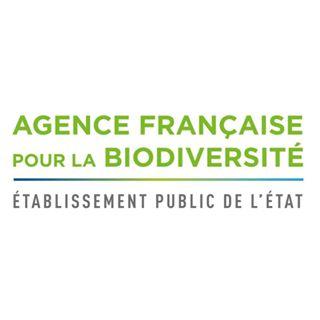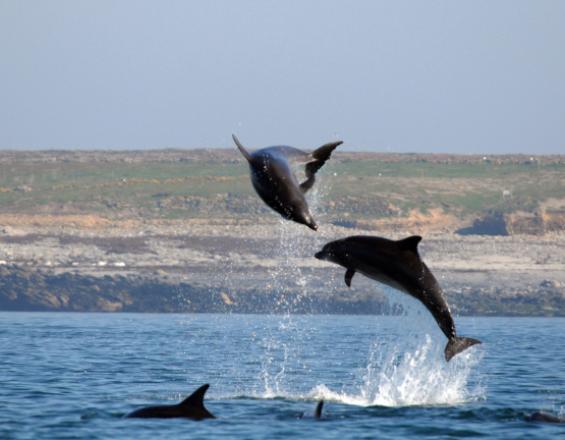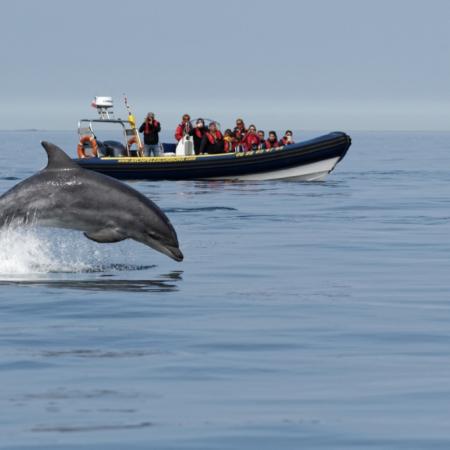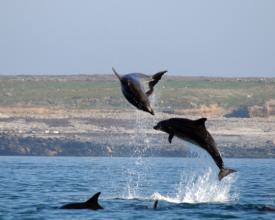
Regulation of jet ski traffic to protect a coastal pod of bottlenose dolphins

The Management Board of the Iroise Marine Park has decided to ban jet skiing in sensitive areas of the Iroise that are home to a coastal group of bottlenose dolphins(Tursiops truncatus). This solution was proposed to the French government to protect the home range of this species, which is highly sensitive to disturbance and noise pollution caused by this type of craft.
The activity is now regulated by a decree issued by the Atlantic Maritime Prefect and prohibited in the home range of coastal bottlenose dolphins. This decision has since been challenged before the competent courts, and the scientific arguments gathered by the Marine Natural Park teams are being used to defend this measure, which is essential for the protection of cetaceans.
Context
Challenges addressed
Maintaining coastal bottlenose dolphin groups against a backdrop of increasing tourism is a major challenge. Indeed, coastal Tursiops ecotypes have to cope with a global increase in tourist activity which, in the long term, is likely to profoundly and durably modify their habitat.
Against this backdrop, we need to find ways of developing visitor activities without modifying or altering the natural environment and the species found there, whose presence reinforces the attractiveness of these coastal areas. In fact, tourism depends on these species and the quality of the natural environment.
Furthermore, the ban on Jet Skiing is localized, and it remains authorized in the less sensitive sectors of the marine park perimeter.
Location
Process
Summary of the process
Blocks 1 and 2 led to the decision in block 3.
Building Blocks
Knowing and protecting the home range of a sensitive species
The first step in this solution is to know exactly the home range of the species to be protected (in this case, Tursiops truncatus). It was therefore necessary to carry out participatory science actions, integrating observation data from tourism companies and setting up a network of hydrophones. Park staff were then trained to observe the bottlenose dolphin. In particular, they learned to detect the animal's activity according to its behavior (hunting, social interactions, resting, etc.). This knowledge was then mapped.
Enabling factors
Means of acquiring knowledge - human, material and financial resources
Competence of the management team
Ability to network with research organizations.
Lesson learned
The means of observation must evolve, as bottlenose dolphins are sensitive to the presence of an observer team, and their behavior changes when the team is present.
Resources
Knowledge of activities in the area
It is very important to identify the activities likely to affect the conservation of the species to be protected. Here, we have identified several sources of nuisance. This text deals only with the nuisance caused by jet-skiing. To confirm the nuisance caused by these machines in our area, we recorded the noise propagated during normal use. Finally, the bibliography enabled us to confirm the nuisance caused.
Enabling factors
Knowledge of measurement/mapping activities and resources.
Lesson learned
Confirmation that jet-skiing is harmful to the conservation of a coastal group of bottlenose dolphins.
Decision-making by the Park Management Board
Thanks to the expertise acquired in Blocks 1 and 2, the Management Board took an informed decision and asked the French government to regulate jet ski traffic in the Molène archipelago. Given the irrefutable nature of the assessment, based on the knowledge acquired by the Park, the French government has decided to ban Jet Skiing in the archipelago.
Enabling factors
Efficient governance, capable of making decisions based on the expertise of the technical teams.
Irrefutable knowledge enabling the State to accept the decision of the management board.
Lesson learned
A conasil de gestion, a governance system representing all maritime stakeholders, can unanimously propose binding regulations.
Impacts
The home range of a coastal bottlenose dolphin group is protected from M/V traffic, which can be a source of disturbance and noise pollution, leading dolphin groups to leave the sites where they have settled.
However, favorable sites for this species are relatively rare, and only around ten coastal sites in Europe are home to one or more groups of coastal dolphins. The productivity and tranquility of the areas they frequent are essential conditions for their survival in coastal areas. In this respect, their presence is a reliable indicator of prey abundance and reduced human pressure.
Maintaining the hosting potential and integrity of the habitats used by these protected and demanding species is an important aspect of the Marine Natural Park's management. Monitoring and assessing the state of the environment and bottlenose dolphin populations is therefore an ongoing task for the Park's teams.
Beneficiaries
The coastal bottlenose dolphin group is the primary beneficiary of these regulations. The companies that organize sea excursions are also beneficiaries, as their activities benefit in part from the presence of this species.
Sustainable Development Goals
Story

Discovering the bottlenose dolphins of the Iroise is an experience I hope many visitors will enjoy. Indeed, being in the middle of a group of dolphins irrevocably generates admiration and fascination. It has to be said that this coastal ecotype has a particularity that makes the bottlenose dolphins of the north-east Atlantic the biggest and most powerful tursiops of all the seas where they can be observed. As a result, the sight of these animals, nearly four meters long and weighing almost 500 kilos, making spectacular leaps above the surface or diving into the clear waters of the Iroise is literally breathtaking! Beyond the spectacular, there's also the impression of power and adaptation to one's environment that subconsciously gives meaning to perfection.
This is all the more true if the animal remains serene and the act of discovery is not intrusive. The less you disturb, the more you see! This is the message we pass on to our dolphin watch and discovery service providers. Unfortunately, such an approach was almost impossible with jet skis, which make the animals nervous as soon as they realize that they can hardly escape from a group of fast-moving, noisy motorized machines. This is even truer when dealing with young individuals who stick close to their mothers, while adult males try to distract them. The trained eye is not deceived...
Yet it's important to share this with the public, so that they learn what we see and develop a natural empathy for the environment that is home to these splendid animals. As a result, the action of the Iroise Marine Park seems logical and well-founded, thanks to a vision that has been transformed by the sight of wild animals perfectly adapted to the sea, which itself is a "trigger" for beauty incarnate.
What's even more impressive is that this fascination is renewed each time, whether by the light on the sea, the reflections of the seaweed beyond the silhouettes of the dolphins, or the tidal currents that the bottlenose dolphins play with. It's unforgettable every time, and that's what's so important to preserve, so that each and every one of us can one day experience these moments...
